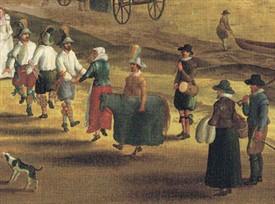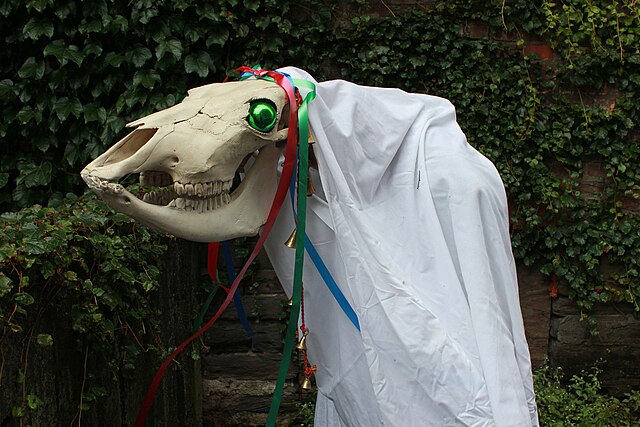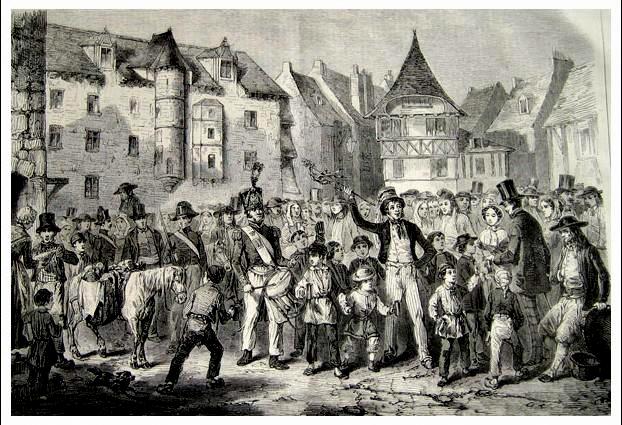The ritual begging of mummers accompanied by the hooden horse (winter hoodening) was a tradition in the British Isles. Samhain (the New Year of the Celts) ended on 11 November with a pagan festival still practiced in the early Middle Ages, to which the Church superimposed the feast of Saint Martin.
THE WINTER HOODENING
MARTINMASS & HOODENING
LÁIR BHÁN
MARI LWYD
HOODEN HORSE
Eginane/Eguinane/Au gui l’an neuf
♬Mari Lwyd carol
♬Mari Lwyd (Hugh Lupton, Chris Wood )
♬Poor Old Horse
♬ Paying off the dead horse (sea shanty)
Hoodening
feast of St Martin
Mumming (winter)
Mumming & St George
Obby Oss Festival
THE WINTER HOODENING

The soulers and the wassailers or more generally the gangs of young people who went around the farms as beggars during the winter festivals were once (and still today) accompanied by the hobby horse.
The spirits of the Earth who govern fertility were depicted as a horse and associated with the young women not yet married (fertility carriers). An even more Celtic connotation is the identification of the “hobby horse” with the Goddess Mare (the Earth Goddess): we find it in the myth of the Welsh goddess Rhiannon and the northern Italian goddess Epona.
For the Celts the horse was a sacred animal, a symbol of royalty and attribute of various deities.
Symbol of wealth and buried together with his master (or worthy of a ritual burial if he fell in battle) the white one was raised by the Druids and used for prophecies and sacrificial rites.
Totemic animal for many Celtic tribes that take its name, its flesh was taboo except in particular ritual times.
MARTINMASS & HOODENING

Historical references to the hobby horse date back to the late Middle Ages (early 1500s) with traces still in the Victorian era: in 1803 the presence of a horse made with the skin of a stallion with a man spraying water on the crowd is documented.
In the Middle Ages the “cavallino” was a character of the cheerful brigade of Robin Hood and was connected with the fertility rituals of the spring festival and the May dances, but also with the Christmas celebrations.
Some scholars trace the ritual back to pre-Christian celebrations connected with the Beltane Celtic festival. But equally numerous are the references to the winter rituals of Samhain.
In the ritual of hoodening a man wears a blanket or a white sheet that covers him entirely and carries a horse’s head on a stick, most commonly a wooden head with jaws with hinges so that it can be maneuvered to open and close ( once a real horse skull). Sometimes a burning candle is placed in the skull with very disturbing effects.

LÁIR BHÁN
At Samhain in Ireland, appalling parades took place in the countryside and in medieval villages, led by Láir Bhán (the white mare) followed by a band of young men waving horns and asking for offers for Muck Olla.
William Hackett wrote (1853): ‘It is not many years since on Samhain’s eve, 31st October, a rustic procession perambulated the district between Ballycotton and Trabolgan, along the coast. The parties represented themselves as messengers of Muck Olla, in whose name they levied contributions on farmers; as usual they were accompanied by sundry youths, sounding lustily on cows’ horns; at the head of the procession was a figure enveloped in a white robe or sheet, having, as it were, the head of a mare, this personage was called the Láir Bhán, “the white mare,” he was a sort of president or master of ceremonies. A long string of verses was recited at each house. (from here)

MARI LWYD
Mari Lwyd, or “Y Fari Lwyd” (in English Gray Mare) is the Welsh version of the hooden horse. Tradition still practiced in central and southern Wales, in particular at Llantrisant and Pontyclun at New Year. The mask consists of a horse’s head (a real skull) with a movable jaw and disquieting eyes made from two pieces of green bottle, decorated with colored ribbons and carried on a pole by a person hidden under a large white cloak. The beggars stop to sing in front of the doors of the houses and call the mistress and challenge her in a pwnco (a challenge in verse). The victory of the singing challenge allows the beggars to enter the house to eat sweets and drink beer.
As can be seen in the illustration by Paul Bommer, the landlady is holding a broom and does not want the group to enter because it is a bringer of disorder. In fact, once the company was entered, the mare would go around the room chasing the women; the mare is clearly a monstrous and otherworldly creature that must be appeased with some offerings and sometimes a small child could calm the beast with a treat.
Mari Lwyd carol
I
Wel dyma ni’n dwad
Gyfeillion diniwad
I ofyn am gennod i ganu
II
Os na chawn ni gennad
Rhowch wybod ar ganiad
Pa fodd mae’r ‘madawiad, nos heno
III
‘Does genni ddim cinio (1)
Nac arian iw gwario
I wneud i chwi roeso, nos heno
I
Here we come
Dear friends
To ask permissions to sing
II
If we don’t have permission,
Let us know in song
How we should go away tonight
III
I have no dinner
Or money to spend
To give you welcome tonight
NOTES
1) if the people were defeated in the poetic battle, Mari Lwyd claimed the right to stay at dinner with all her followers. Alternatively they offered a glennig (a small tip), a glass of glaster (water and milk) or beer.
Lyrics
https://www.omniglot.com/songs/bcc/marilwyd.php
http://www.folkwales.org.uk/arctd9a.html
The legend behind the Mari Lwyd tradition is that of the gray mare forced to leave the stable in Bethlehem to make room for Mary in labor. Since then, the Celtic mare has still been looking for a place to give birth to her foal.
A clear allegory of the Christian faith supplanting that of the mare-goddess Rhiannon-Epona put into verse by the poet Hugh Lupton, listen to the story set to music by Chris Wood
Mari Lwyd (Hugh Lupton, Chris Wood )
The Hodening hoss, the marbury dun (1),
Old Bone-face the deathless am I,
Heavy with Foal two thousand years
Bridled with sorrow, saddled with fear,
I canter through pastures of tremble and quake,
I gallop the track between sleep and awake
Seeking the deep of welcome
and stint for my tears.
The mare queen the Mari-Lwyd
I was mother of all the herds
Ten thousand years my shining foals
Bridled with starlight saddled with gold
I leapt the divide between living and dead
I quickened each year with a toss of my head
Seeking the deep of beauty
and never grew old
But Mother of God, The Mary Mild.
The pregnant Virgin came bursting with Jehovah seed
entered my stable and cried out her need
With ropes I was dragged from the birthing straw
Aching with foal I was heaved to the door
Swapping warmth for bitter weather
And birth of a rival creed
So now I am nightmare I am rattling womb
The Uffington wraith(2) I’ve become
Forced into dark you’ve made me a fiend
Bridled with shadow saddled with scream
From window to window traversing the night
My face in your glass in a shudder of light
Seeking that deep of welcome befitting a Queen
Let me in once again
Let me in!
(1) dun is a gray-brown horse; the legend says that Marbury Dun ran from London to Marbury on a bet (to complete the route in one day).
The horse won the bet but exhausted after drinking at the Budworth Mother he died
(2) the white horse of Uffington drawn on the slope of a hill in prehistoric times a geoglyph on the hill called White Horse Hill near the village of Uffington in Oxfordshire. A recent dating has moved its origin to the Bronze Age

HOODEN HORSE
In Kent the Heningening groups have returned (in the villages of San Nicola-a-Wade, Nether Hale, Sarre), in particular the tradition is very rooted in San Nicola-a-Wade where the hooden horse is called Dobbin, an old man poor horse exhausted by the labor of work: a sort of “sacred representation” is staged with various characters and songs; once the teams of hoodening went from house to house with musicians and the clatter of bells: the horse was accompanied by a group of peasants, one who holds the reins (the tamer), the other who carries a basket of fruit an another on the back, there is also “Mollie” or the “old lady” who carries a broom. Here the master knocks and as soon as the door is opened the horse kicks and scares, opening his mouth wide, while Mollie fucks the feet of one who has opened the door.. (see more)
The Horse regularly appeared through the year at, especially in Midwinter (Hallowtide, the Twelve Days of Christmas, et al). The Horse was a man dressed as an animal, covered in blanket and carrying a horse’s head, with reins, on a pole. The head was sometimes wooden but usually a real horse skull – hinged jaws allowed the mouth to snap open and shut. Along with other young men the horse ‘galloped’ and visited houses as a ‘lick-bringer’. This was not always successful and in 1839 at Broadstairs a woman was so terrified coming face-to-face with the ‘horse’ she died of fright. The custom was subsequently forbidden by local magistrates.
In East Kent Hoodening took place at Christmas. The Horse had a wooden head and sometimes a lighted candle was placed in the mouth. Farmworkers walked with the horse, one leading it by the reins or a rope and carrying a whip, and another worker light enough to ride on the horse’s back. A third known as Mollie or Old Woman was in female attire and carried a broom or besom.
In Reculver, only men who had worked with horses during the year were allowed to partake. (in “A Dictionary of British Folk Customs” di Christina Hole, 1995 from here)
POOR OLD HORSE
[ Roud 513 ; TYG 60 ; Ballad Index ShH85 ; VWML CJS2/10/2583 , TFO/1/31/33/1 ; Bodleian Roud 513 ; GlosTrad Roud 513 ; Wiltshire 661 , 663 , 933 ; trad.]933 ; trad.]
There are many versions of the song, which was a part of the Mummers play, who staged the death and resurrection of the horse
I
My clothing was once of a linsey-woolsey fine,
My mane it was sleek
and my body it did shine.
But now I’m getting old
and I’m going to decay,
Me master frowns upon me
and thus they all do say, “Poor old horse.”
II
My living was once to the best of corn and hay
As ever grew in England,
and that they all did say.
But now there’s no such comfort
as I can find at all.
I’m forced to nab the short grass
that grows against the wall,
“Poor old horse.”
I
We’ve got a poor old horse,
He’s standing at your door,
And if you’ll only let him in,
He’ll please you all (1) I’m sure (x2)
II
Now that he’s grown old
And nature doth decay,
My master frowns upon him now,
These words I’ve heard him say (x2)
III
Now that he’s grown old
And scarcely can he crawl,
He’s forced to eat the coarsest grass
That grows against the wall (x2)
IV
This poor horse was once young,
And in his youthful prime
My master used to ride on him,
He thought him very fine (x2)
NOTE
1) in the verse the song is highlighted as a begging song with propitiatory ritual
This version is only a fragment and the initial part is missing in which the mummers / soulers ask to be welcomed at home
Eginane/Eguinane/Au gui l’an neuf
Christian Souchon describes a Breton Christmas quest (tradition known as Eginane or Au gui l’an neuf) reported by Villemarqué “In olden times Brittany, Christmas was, above all, the feast of the poor. On Boxing day, they went in groups from hamlet to hamlet, with an old horse adorned with laurel and ribbons ahead of them, to collect Christmas gifts. They did it in singing a song whose subject never varied, but that was altered to fit the singers’ inspiration of the moment. They would stop in front of each rich looking doorway and their leader would start with one of the house dwellers a verbal contest which he always won after a long resistance. Here is an instance of such battle of wits, noted by La Villemarqué in Spézet, Black Mountain (BB 1867, p.452).“[http://chrsouchon.free.fr/eginanef.htm]
In some places in Brittany begging took place the day before Christmas or on New Year’s Eve, a guessing contest identical to the Welsh tradition of the Hoodening or it took place in the streets with a series of verses very similar to the wassailing songs of the British Isles

LINK
http://ontanomagico.altervista.org/epona.html
http://paleopix.com/blog/2013/10/31/lair-bhan-and-the-mast-beast/
https://thefadingyear.wordpress.com/2016/10/26/origins-of-trick-or-treating/
https://www.omniglot.com/songs/bcc/marilwyd.php
http://www.folkwales.org.uk/arctd9a.html
http://hoodening.org.uk/hooden-horses.html
http://www.hoodening.org.uk/hoodening-history1.html
http://paulbommer.blogspot.it/2010/12/advent-calendar-22nd-mari-lwyd.html
http://www.museumwales.ac.uk/cy/279/
http://mainlynorfolk.info/shirley.collins/songs/pooroldhorse.html
http://chrsouchon.free.fr/eginanef.htm

